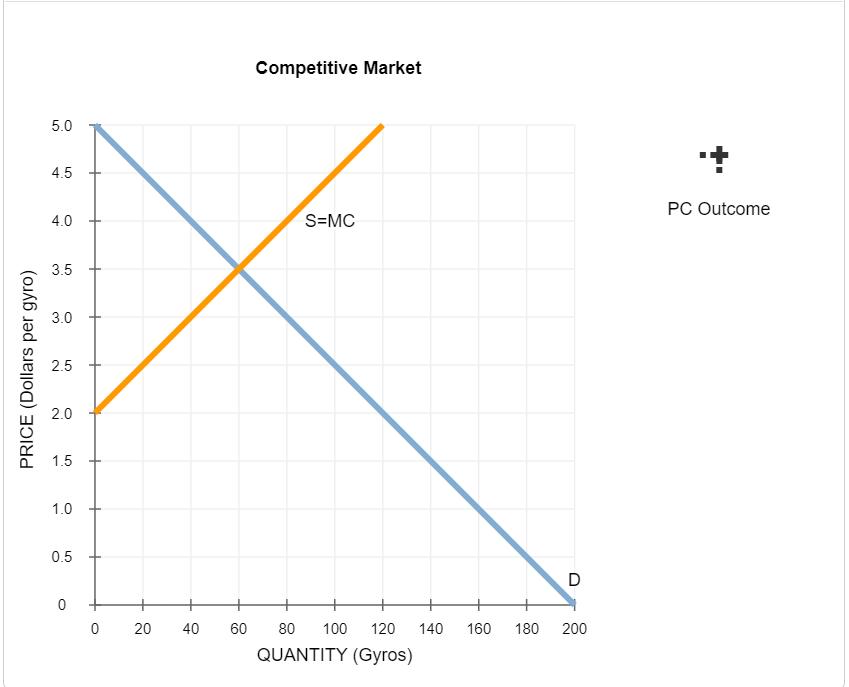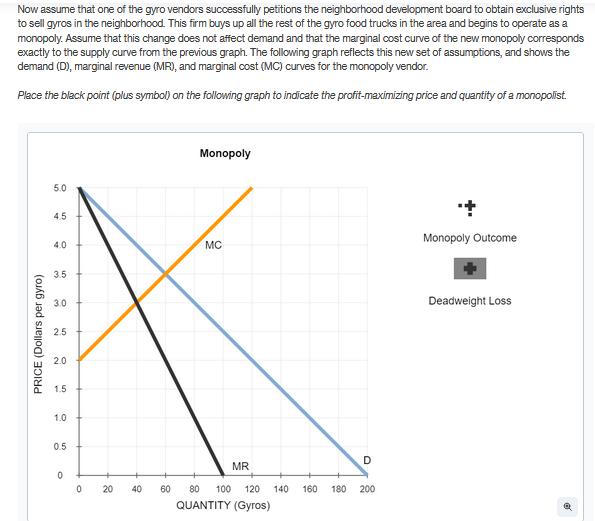Answered step by step
Verified Expert Solution
Question
1 Approved Answer
Consider the weekly market for gyros in a popular neighborhood close to campus. Suppose this market is operating in long-run competitive equilibrium with many





Consider the weekly market for gyros in a popular neighborhood close to campus. Suppose this market is operating in long-run competitive equilibrium with many gyro vendors in the neighborhood, each offering basically the same gyros. Due to the structure of the market, the vendors act as price takers and each individual vendor has no market power. The following graph displays the supply (SMC) and demand (D) curves in the weekly market for gyros. Place the black point (plus symbol) on the graph to indicate the market price and quantity that will result from competition. PRICE (Dollars per gyro) 5.0 4.5 Competitive Market PC Outcome 4.0 S=MC 3.5 3.0 2.5 2.0 1.5 1.0 0.5 0 0 20 20 40 40 D 60 80 100 120 140 160 180 200 QUANTITY (Gyros) Now assume that one of the gyro vendors successfully petitions the neighborhood development board to obtain exclusive rights to sell gyros in the neighborhood. This firm buys up all the rest of the gyro food trucks in the area and begins to operate as a monopoly. Assume that this change does not affect demand and that the marginal cost curve of the new monopoly corresponds exactly to the supply curve from the previous graph. The following graph reflects this new set of assumptions, and shows the demand (D), marginal revenue (MR), and marginal cost (MC) curves for the monopoly vendor. Place the black point (plus symbol) on the following graph to indicate the profit-maximizing price and quantity of a monopolist. PRICE (Dollars per gyro) 5.0 4.5 Monopoly 4.0 Monopoly Outcome MC 3.5 3.0 2.5 2.0 1.5 1.0 0.5 MR D 0 0 20 40 60 80 100 120 140 160 180 200 QUANTITY (Gyros) Deadweight Loss Consider the welfare effects that result from the industry operating as a competitive market versus a monopoly. On the monopoly graph, use the black points (plus symbol) to shade the area that represents the loss of welfare, or deadweight loss, caused by a monopoly. That is, show the area that was formerly part of total surplus and now does not accrue to anybody. Deadweight loss occurs when a market is controlled by a monopoly because the resulting equilibrium is different from the (efficient) competitive outcome. In the following table, enter the price and quantity that would arise in a competitive market; then enter the profit-maximizing price and quantity that would be chosen if a monopolist controlled this market Price Quantity (Gyros) Market Structure (Dollars) Competitive Monopoly Given the summary table of the two different market structures, you can infer that, in general, the price is higher under a and the quantity is lower under a
Step by Step Solution
There are 3 Steps involved in it
Step: 1
Solutions Select all that apply A The sliding scale insulin lispro order B The type of insulin to be administered C The insulin vial for color and cla...
Get Instant Access to Expert-Tailored Solutions
See step-by-step solutions with expert insights and AI powered tools for academic success
Step: 2

Step: 3

Ace Your Homework with AI
Get the answers you need in no time with our AI-driven, step-by-step assistance
Get Started


